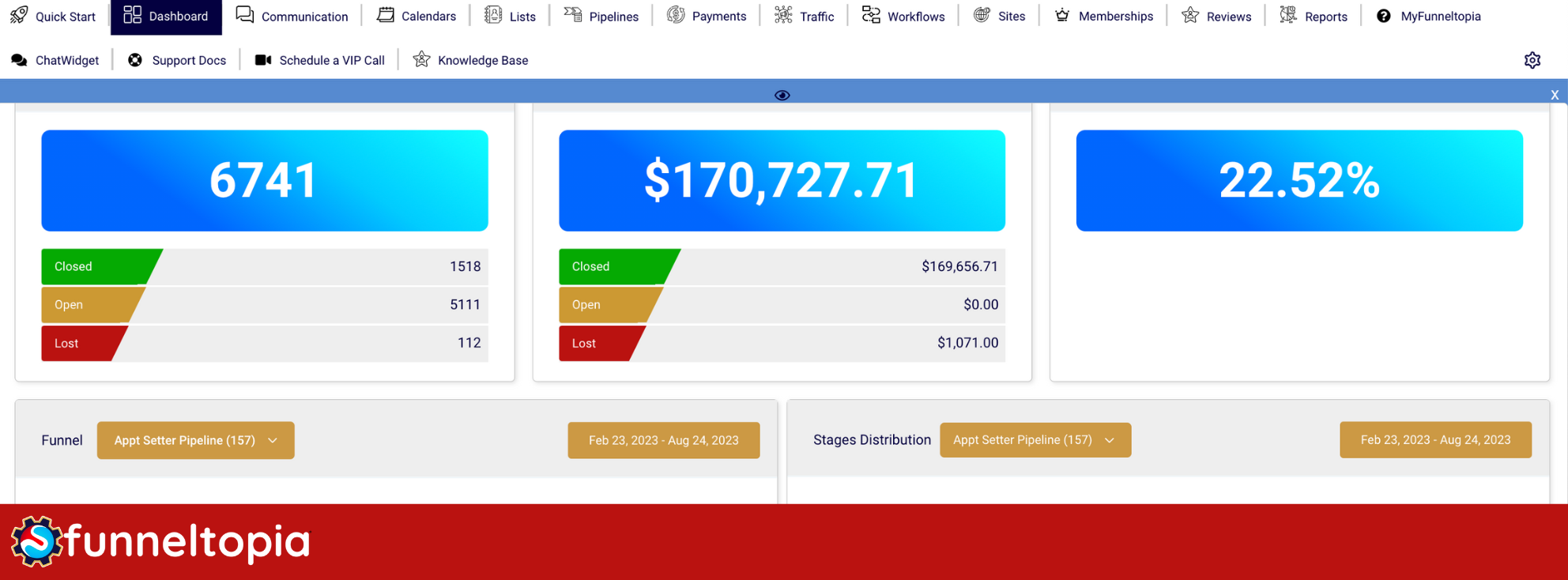
The Sales Productivity Handbook for Sales Managers and Sales Leaders
Introduction and Understanding Sales Productivity
Introduction: The Importance of Sales Productivity
Sales productivity has become a focal point for sales organizations in the past few years, especially in the digital marketing landscape. Understanding how to measure sales productivity, improve the bottom line, and consistently exceed sales targets is essential for business owners, sales leaders, and digital marketers. Sales performance indicators are key to tracking progress and ensuring that sales goals are met.
The Evolution of Sales Productivity
Historically, sales productivity was measured by the sheer volume of sales. With the advent of technology, the focus has shifted to quality, efficiency, and alignment with overall business goals. From door-to-door sales to digital platforms, the evolution of sales productivity reflects a more nuanced understanding of customer needs and market trends.

Understanding Sales Productivity
Defining Sales Productivity
Understanding what sales productivity (or sales efficiency) means and how it affects your bottom line is the first step. Sales productivity is about more than just numbers; it's about effective sales force management and alignment with business goals. Sales professionals must work together to optimize productivity and achieve significant growth.
Why Measure Sales Productivity?
Sales performance affects your bottom line. In a poor performance environment, salespeople do not generate sufficient profits to cover the cost. Tracking sales productivity is essential to improve sales efficiency and morale. Measuring leading indicators can provide insights into areas for improvement.
Sales Productivity Metrics
Selecting the right sales productivity metrics is crucial. Key performance indicators must align with your company's workflow and goals. Understanding how leading companies track productivity can provide valuable insights. Sales organizations must focus on metrics that reflect the sales cycle and the number of sales achieved.
Challenges in Measuring Sales Productivity
Measuring sales productivity is not straightforward. Different metrics, subjective evaluations, and the balance between quality and quantity can create confusion. The challenge lies in identifying the right KPIs that align with both short-term and long-term goals, ensuring that they reflect the true value of a sales team's efforts.
Importance of Team Collaboration
Team collaboration is vital in sales productivity. A cohesive team that shares insights, works towards common goals, and supports each other can lead to innovative solutions and a more profound understanding of customer needs. Collaboration fosters creativity and ensures that the sales strategy is executed seamlessly.
Impact of Sales Productivity on Other Departments
Sales productivity doesn't operate in a vacuum. An efficient sales team can lead to better marketing strategies, improved customer service, and overall business growth. The ripple effect of sales productivity can be felt across various departments, emphasizing the need for alignment and collaboration.
Strategies to Improve Sales Productivity
Sales Enablement
Sales enablement is what “enables” sales professionals to work harder. It's more than just providing tools; it's about creating a strategy that aligns with the sales process and overall sales strategy. Sales enablement tools are essential for improving sales productivity and efficiency.

Role of Leadership in Sales Enablement
Leadership plays a crucial role in sales enablement. Effective leaders provide the resources, guidance, and support that sales teams need to succeed. They foster a culture of continuous learning and innovation, setting the tone for a sales enablement strategy that aligns with the company's vision and goals.
Sales Training and Coaching
Sales training and coaching are not one-time events. Continuous, personalized training can have a significant impact on sales reps productivity. Investing in sales training can prevent knowledge loss and improve sales effectiveness. Sales coaching sessions must be regular and tailored to the needs of the sales reps.

Importance of Personalized Coaching
Every sales rep is unique, and personalized coaching recognizes this individuality. Tailored coaching that addresses specific strengths and weaknesses can lead to improved performance, higher morale, and a more engaged sales team. It's an investment that pays dividends in the form of increased sales and customer satisfaction.
Evaluating the Effectiveness of Sales Training
Assessing the success of sales training programs requires a careful analysis of metrics like performance improvement, ROI, and employee engagement. Regular evaluations ensure that training remains relevant, effective, and aligned with the ever-changing sales landscape.
Aligning Sales and Marketing
Creating a sales-oriented business requires alignment between sales and marketing. Collaboration and shared goals can lead to more deals and increased company revenue. Sales teams must work closely with marketing to ensure that the sales funnel is effectively managed.
Role of Technology in Sales Enablement
Technology has become a cornerstone in sales enablement. From CRM systems to AI-powered analytics, technology equips sales teams with the tools they need to succeed. It streamlines processes, provides valuable insights, and allows sales professionals to focus on what they do best: selling.
Implementing Artificial Intelligence (AI)
AI-guided selling helps sales representatives leverage data to enhance performance. AI can detect patterns and optimize productivity, leading to significant growth. Tech solutions like AI can transform the sales process and increase the number of sales.
The Impact of AI on Sales
AI is transforming the sales landscape. From chatbots that handle customer inquiries to predictive analytics that forecast sales trends, AI enables sales teams to work smarter, not harder. It's a game-changer that offers unprecedented efficiency and insights, paving the way for a new era in sales.
Tools and Technologies for Sales Productivity
In today's competitive sales landscape, leveraging the right tools and technologies is essential for achieving success. One such tool that stands out is Funneltopia, a comprehensive Customer Relationship Management (CRM) system designed to enhance sales productivity. Funneltopia offers a wide array of features that cater to various aspects of the sales process, from communication and opportunity management to payment processing and reporting. Whether you're a small business looking to grow or a large enterprise aiming to streamline your sales operations, Funneltopia provides tailored solutions to meet your unique needs.
Best Tools for Tracking Sales Productivity
Funneltopia is a popular choice for measuring sales effectiveness. Integrating this CRM system into your business can improve customer satisfaction and streamline the sales process. With features like Conversations, Calendars, Opportunities, and Payments, Funneltopia is advancing sales technology, and utilizing its optimal tools can enhance the sales team's productivity.

Integrating Different Sales Tools
Integration is key in a tech-driven sales environment. Funneltopia offers seamless integration between tools like email marketing platforms, analytics tools, and more, ensuring a smooth workflow. It allows for real-time data sharing and collaboration, enhancing efficiency and productivity.
User Experience in Sales Tools
Funneltopia's user-friendly interface is more likely to be adopted and utilized effectively by sales teams. Intuitive navigation and responsive design all contribute to a positive user experience. Investing in Funneltopia is an investment in your sales team's success.
Sales Intelligence Software
Funneltopia's Sales Intelligence features, such as Social Planner and Analyzing Trigger Links, can be invaluable for connecting specific talk points to business contacts before reaching out. These tools help identify opportunities and target potential customers effectively.
The Future of Sales Intelligence Software
With Funneltopia, sales intelligence software is evolving at a rapid pace. Future trends may include deeper integration with AI, real-time data analysis, and enhanced customization to cater to specific industry needs. Staying abreast of these trends will be vital for sales organizations looking to maintain a competitive edge.
Sales Automation
Funneltopia's Sales Automation allows sales reps to focus on generating revenue rather than administrative tasks. Implementing its Workflows, Workflow Triggers, and Workflow Actions can free up the sales team's time and boost productivity. Automation can also reduce repetitive tasks and data entry, allowing sales reps to start selling more efficiently.

Benefits of Automation in Sales
Automation in Funneltopia offers numerous advantages, from time savings to improved data accuracy. By automating repetitive tasks, sales reps can focus on building relationships and closing deals. Automation also ensures consistency and compliance, making it an essential component of modern sales strategy.
Monitoring and Evaluating Sales Performance
Time Management and Performance Monitoring
Managing sales opportunities requires constant monitoring. Time management and tracking key performance indicators can improve the organization's effectiveness. Sales team leaders must ensure that time spent selling is optimized, and internal meetings are productive.
Effective Time Management Strategies
Time is a precious commodity in sales. Effective time management strategies include setting clear priorities, using tech tools for scheduling, and eliminating unnecessary tasks. By managing time wisely, sales reps can focus on high-impact activities that drive sales and revenue.

Sales Rep Quotas and Goals
Setting realistic targets and quotas for sales reps is essential. Understanding conversion rates and aligning them with past performance ensures that goals are achievable. Sales leaders must set clear expectations and provide support to help sales reps meet their quotas.
Motivating Sales Reps to Meet Quotas
Motivation is key to meeting sales quotas. Strategies may include incentive programs, recognition, career advancement opportunities, and regular feedback. A motivated sales team is more likely to be engaged, productive, and successful in meeting and exceeding their targets.
Creating a Positive Sales Culture
A positive sales culture fosters a supportive environment where sales reps feel valued and motivated. It encourages collaboration, innovation, and continuous improvement. Building such a culture requires leadership commitment, clear communication, and alignment with core values.
Incentives and Rewards for Sales Reps
Incentives and rewards can be powerful motivators. From monetary bonuses to non-tangible rewards like recognition and growth opportunities, a well-designed incentive program can drive performance, boost morale, and contribute to a positive sales culture.
Evaluating Low Impact Activities
Eliminating or automating low impact activities can boost productivity. Identifying opportunities for technological solutions can lead to more efficient sales processes. Sales executives must focus on high-impact activities that lead to closing deals and generating revenue.
Advanced Strategies for Sales Success
Integrating and Automating Your Playbook or Strategy
A well-defined playbook can be a game-changer. Integrating and automating it ensures that sales reps refer to it and follow the established sales processes. Companies must keep the playbook updated to reflect changes in the sales cycle and market trends.

Challenges in Integrating Playbooks
Integrating playbooks into the sales process can be challenging. Potential roadblocks include resistance to change, lack of clarity in guidelines, and misalignment with current practices. Overcoming these challenges requires clear communication, training, and ongoing support.
Innovative Approaches to Sales Playbooks
Sales playbooks are evolving, and innovative approaches include leveraging tech tools, incorporating feedback loops, and aligning with customer journey mapping. These new trends reflect a more dynamic, customer-centric approach to sales, ensuring that playbooks remain relevant and effective.
Defining and Measuring Core Competencies
Comparing a rep's behavior to progress and measuring competency improvement can lead to better sales results. Planning and goal setting are key components of this process. Sales leaders must define core competencies and measure them regularly to ensure continuous improvement.
Sales Coaching and Development
Importance of Sales Coaching
Sales coaching is vital for the development of sales reps. Regular coaching sessions can help sales reps understand their strengths and weaknesses and improve their skills. Sales leaders must invest in sales coaching to enhance the overall effectiveness of the sales team.
Peer-to-Peer Coaching in Sales
Peer coaching offers a unique opportunity for sales reps to learn from each other. It fosters a collaborative environment where insights, experiences, and best practices are shared. Peer coaching can be a valuable supplement to formal training, enhancing skills and building team cohesion.
Sales Training Programs
Investing in sales training programs can enhance the effectiveness of the sales team. Tailored training modules can address the specific needs of sales reps and help them achieve their sales goals. Continuous training is essential for maintaining sales efficiency and keeping the sales team aligned with the company's business objectives.

Ongoing Support for Sales Rep Development
Sales rep development is an ongoing process. Continuous support in the form of resources, training, and mentorship ensures that sales reps continue to grow and adapt to the ever-changing sales landscape. It's an investment in the future success of both the individual and the organization.
Sales Technology and Tools
Leveraging Digital Tools
Sales technology, such as AI and automation tools, can significantly enhance the sales process. Utilizing the right tools can lead to increased efficiency and effectiveness. Every business must stay abreast of the latest technological advancements to remain competitive.
The Role of Mobile Technology in Sales
Mobile technology has become an essential tool for sales reps. From accessing CRM on the go to conducting virtual meetings, smartphones, and tablets enable sales professionals to be more flexible, responsive, and efficient. Mobile technology is not just a convenience; it's a necessity in today's fast-paced sales environment.

Sales Tools for Success
Various digital tools, including CRM and sales intelligence software, can streamline the sales process. These tools can help sales reps save time and focus on closing deals. Sales leaders must ensure that the sales team is equipped with the adequate tools to increase productivity.
Selecting the Right Sales Tools for Small Businesses
Small businesses have unique needs and constraints. Selecting the right sales tools requires a careful assessment of budget, scalability, and specific business goals. Tailored solutions that offer value without overwhelming complexity can be a game-changer for small businesses looking to grow.
Sales Meetings and Collaboration
Conducting Effective Sales Meetings
Sales meetings are essential for aligning the sales team and discussing strategies. Regular meetings can foster collaboration and ensure that everyone is on the same level. Sales team leaders must conduct effective sales meetings to keep the team motivated and focused.
Post-Meeting Follow-ups
The work doesn't end when the meeting does. Post-meeting follow-ups, including summary emails, action items, and scheduling next steps, ensure that momentum is maintained and goals are achieved. Follow-ups are an essential part of the sales process, reflecting professionalism and commitment.
Collaborating In Person and Virtually
Collaborating in person or through virtual platforms can enhance teamwork. Regular interactions can foster a sense of unity and shared purpose among sales reps. Sales leaders must encourage collaboration to drive sales effectiveness.

Building Trust in Virtual Collaboration
Trust is the foundation of effective collaboration, especially in a virtual environment. Strategies for building trust include clear communication, transparency, regular check-ins, and a commitment to follow through. Trust fosters a positive collaborative culture where ideas flow freely and teamwork thrives.
Sales Pipeline and Conversion Rate
Managing the Sales Pipeline
Managing sales pipelines is crucial for tracking leads and closing deals. Effective management can lead to increased sales and revenue. Sales executives must focus on pipeline management to ensure a steady flow of new business.

Leveraging Data Analytics in Pipeline Management
Data analytics offers valuable insights into the sales pipeline. From identifying bottlenecks to predicting future trends, data-driven insights enable sales teams to make informed decisions and optimize the sales process. Leveraging data is not just about numbers; it's about understanding the story behind the numbers.
Understanding Conversion Rate
The conversion rate is a vital metric that reflects the number of sales made from prospective customers. Analyzing and improving the conversion rate can lead to more deals and business growth. Sales managers must monitor the conversion rate to recognize opportunities for improvement.
Personalizing Sales Approaches for Better Conversion
Personalization is key to conversion. Tailoring sales pitches and strategies based on individual customer needs, preferences, and behaviors leads to more engaging and effective sales interactions. Personalization is not a one-size-fits-all approach; it's a customer-centric strategy that builds relationships and drives sales.
Social Media and Sales
Social media platforms are becoming increasingly important in the sales process. Sales teams can leverage these platforms to engage with potential customers, understand their pain points, and offer tailored solutions. These platforms can also be used for lead generation, allowing sales reps to connect with prospects and build relationships.

Customer Retention and Growth
Retaining existing customers and encouraging repeat business is essential for long-term success. Businesses must focus on building strong relationships with existing customers, understanding their needs, and providing exceptional service. Customer retention strategies can lead to increased loyalty and more opportunities for upselling and cross-selling.

The Future of Sales
The sales landscape is constantly evolving, and every company must adapt to stay ahead of the competition. Emerging technologies, changing customer expectations, and new business models are shaping the future of sales. Sales leaders must be proactive in exploring new opportunities and embracing innovation to drive growth and success.

Conclusion: Driving Sales Productivity Forward
Improving sales productivity is a multifaceted task that requires understanding, planning, implementing strategies, and continuous monitoring. By focusing on the areas outlined above, digital marketers and business owners can create a robust sales organization that not only meets but exceeds sales goals. Sales enablement, sales coaching, sales technology, and efficient sales team management management are key components in achieving success. Sales professionals must work together to achieve common goals and drive exponential growth in the business


The Sales Productivity Handbook for Sales Managers and Sales Leaders
Introduction and Understanding Sales Productivity
Introduction: The Importance of Sales Productivity
Sales productivity has become a focal point for sales organizations in the past few years, especially in the digital marketing landscape. Understanding how to measure sales productivity, improve the bottom line, and consistently exceed sales targets is essential for business owners, sales leaders, and digital marketers. Sales performance indicators are key to tracking progress and ensuring that sales goals are met.
The Evolution of Sales Productivity
Historically, sales productivity was measured by the sheer volume of sales. With the advent of technology, the focus has shifted to quality, efficiency, and alignment with overall business goals. From door-to-door sales to digital platforms, the evolution of sales productivity reflects a more nuanced understanding of customer needs and market trends.

Understanding Sales Productivity
Defining Sales Productivity
Understanding what sales productivity (or sales efficiency) means and how it affects your bottom line is the first step. Sales productivity is about more than just numbers; it's about effective sales force management and alignment with business goals. Sales professionals must work together to optimize productivity and achieve significant growth.
Why Measure Sales Productivity?
Sales performance affects your bottom line. In a poor performance environment, salespeople do not generate sufficient profits to cover the cost. Tracking sales productivity is essential to improve sales efficiency and morale. Measuring leading indicators can provide insights into areas for improvement.
Sales Productivity Metrics
Selecting the right sales productivity metrics is crucial. Key performance indicators must align with your company's workflow and goals. Understanding how leading companies track productivity can provide valuable insights. Sales organizations must focus on metrics that reflect the sales cycle and the number of sales achieved.
Challenges in Measuring Sales Productivity
Measuring sales productivity is not straightforward. Different metrics, subjective evaluations, and the balance between quality and quantity can create confusion. The challenge lies in identifying the right KPIs that align with both short-term and long-term goals, ensuring that they reflect the true value of a sales team's efforts.
Importance of Team Collaboration
Team collaboration is vital in sales productivity. A cohesive team that shares insights, works towards common goals, and supports each other can lead to innovative solutions and a more profound understanding of customer needs. Collaboration fosters creativity and ensures that the sales strategy is executed seamlessly.
Impact of Sales Productivity on Other Departments
Sales productivity doesn't operate in a vacuum. An efficient sales team can lead to better marketing strategies, improved customer service, and overall business growth. The ripple effect of sales productivity can be felt across various departments, emphasizing the need for alignment and collaboration.
Strategies to Improve Sales Productivity
Sales Enablement
Sales enablement is what “enables” sales professionals to work harder. It's more than just providing tools; it's about creating a strategy that aligns with the sales process and overall sales strategy. Sales enablement tools are essential for improving sales productivity and efficiency.

Role of Leadership in Sales Enablement
Leadership plays a crucial role in sales enablement. Effective leaders provide the resources, guidance, and support that sales teams need to succeed. They foster a culture of continuous learning and innovation, setting the tone for a sales enablement strategy that aligns with the company's vision and goals.
Sales Training and Coaching
Sales training and coaching are not one-time events. Continuous, personalized training can have a significant impact on sales reps productivity. Investing in sales training can prevent knowledge loss and improve sales effectiveness. Sales coaching sessions must be regular and tailored to the needs of the sales reps.

Importance of Personalized Coaching
Every sales rep is unique, and personalized coaching recognizes this individuality. Tailored coaching that addresses specific strengths and weaknesses can lead to improved performance, higher morale, and a more engaged sales team. It's an investment that pays dividends in the form of increased sales and customer satisfaction.
Evaluating the Effectiveness of Sales Training
Assessing the success of sales training programs requires a careful analysis of metrics like performance improvement, ROI, and employee engagement. Regular evaluations ensure that training remains relevant, effective, and aligned with the ever-changing sales landscape.
Aligning Sales and Marketing
Creating a sales-oriented business requires alignment between sales and marketing. Collaboration and shared goals can lead to more deals and increased company revenue. Sales teams must work closely with marketing to ensure that the sales funnel is effectively managed.
Role of Technology in Sales Enablement
Technology has become a cornerstone in sales enablement. From CRM systems to AI-powered analytics, technology equips sales teams with the tools they need to succeed. It streamlines processes, provides valuable insights, and allows sales professionals to focus on what they do best: selling.
Implementing Artificial Intelligence (AI)
AI-guided selling helps sales representatives leverage data to enhance performance. AI can detect patterns and optimize productivity, leading to significant growth. Tech solutions like AI can transform the sales process and increase the number of sales.
The Impact of AI on Sales
AI is transforming the sales landscape. From chatbots that handle customer inquiries to predictive analytics that forecast sales trends, AI enables sales teams to work smarter, not harder. It's a game-changer that offers unprecedented efficiency and insights, paving the way for a new era in sales.
Tools and Technologies for Sales Productivity
In today's competitive sales landscape, leveraging the right tools and technologies is essential for achieving success. One such tool that stands out is Funneltopia, a comprehensive Customer Relationship Management (CRM) system designed to enhance sales productivity. Funneltopia offers a wide array of features that cater to various aspects of the sales process, from communication and opportunity management to payment processing and reporting. Whether you're a small business looking to grow or a large enterprise aiming to streamline your sales operations, Funneltopia provides tailored solutions to meet your unique needs.
Best Tools for Tracking Sales Productivity
Funneltopia is a popular choice for measuring sales effectiveness. Integrating this CRM system into your business can improve customer satisfaction and streamline the sales process. With features like Conversations, Calendars, Opportunities, and Payments, Funneltopia is advancing sales technology, and utilizing its optimal tools can enhance the sales team's productivity.

Integrating Different Sales Tools
Integration is key in a tech-driven sales environment. Funneltopia offers seamless integration between tools like email marketing platforms, analytics tools, and more, ensuring a smooth workflow. It allows for real-time data sharing and collaboration, enhancing efficiency and productivity.
User Experience in Sales Tools
Funneltopia's user-friendly interface is more likely to be adopted and utilized effectively by sales teams. Intuitive navigation and responsive design all contribute to a positive user experience. Investing in Funneltopia is an investment in your sales team's success.
Sales Intelligence Software
Funneltopia's Sales Intelligence features, such as Social Planner and Analyzing Trigger Links, can be invaluable for connecting specific talk points to business contacts before reaching out. These tools help identify opportunities and target potential customers effectively.
The Future of Sales Intelligence Software
With Funneltopia, sales intelligence software is evolving at a rapid pace. Future trends may include deeper integration with AI, real-time data analysis, and enhanced customization to cater to specific industry needs. Staying abreast of these trends will be vital for sales organizations looking to maintain a competitive edge.
Sales Automation
Funneltopia's Sales Automation allows sales reps to focus on generating revenue rather than administrative tasks. Implementing its Workflows, Workflow Triggers, and Workflow Actions can free up the sales team's time and boost productivity. Automation can also reduce repetitive tasks and data entry, allowing sales reps to start selling more efficiently.

Benefits of Automation in Sales
Automation in Funneltopia offers numerous advantages, from time savings to improved data accuracy. By automating repetitive tasks, sales reps can focus on building relationships and closing deals. Automation also ensures consistency and compliance, making it an essential component of modern sales strategy.
Monitoring and Evaluating Sales Performance
Time Management and Performance Monitoring
Managing sales opportunities requires constant monitoring. Time management and tracking key performance indicators can improve the organization's effectiveness. Sales team leaders must ensure that time spent selling is optimized, and internal meetings are productive.
Effective Time Management Strategies
Time is a precious commodity in sales. Effective time management strategies include setting clear priorities, using tech tools for scheduling, and eliminating unnecessary tasks. By managing time wisely, sales reps can focus on high-impact activities that drive sales and revenue.

Sales Rep Quotas and Goals
Setting realistic targets and quotas for sales reps is essential. Understanding conversion rates and aligning them with past performance ensures that goals are achievable. Sales leaders must set clear expectations and provide support to help sales reps meet their quotas.
Motivating Sales Reps to Meet Quotas
Motivation is key to meeting sales quotas. Strategies may include incentive programs, recognition, career advancement opportunities, and regular feedback. A motivated sales team is more likely to be engaged, productive, and successful in meeting and exceeding their targets.
Creating a Positive Sales Culture
A positive sales culture fosters a supportive environment where sales reps feel valued and motivated. It encourages collaboration, innovation, and continuous improvement. Building such a culture requires leadership commitment, clear communication, and alignment with core values.
Incentives and Rewards for Sales Reps
Incentives and rewards can be powerful motivators. From monetary bonuses to non-tangible rewards like recognition and growth opportunities, a well-designed incentive program can drive performance, boost morale, and contribute to a positive sales culture.
Evaluating Low Impact Activities
Eliminating or automating low impact activities can boost productivity. Identifying opportunities for technological solutions can lead to more efficient sales processes. Sales executives must focus on high-impact activities that lead to closing deals and generating revenue.
Advanced Strategies for Sales Success
Integrating and Automating Your Playbook or Strategy
A well-defined playbook can be a game-changer. Integrating and automating it ensures that sales reps refer to it and follow the established sales processes. Companies must keep the playbook updated to reflect changes in the sales cycle and market trends.

Challenges in Integrating Playbooks
Integrating playbooks into the sales process can be challenging. Potential roadblocks include resistance to change, lack of clarity in guidelines, and misalignment with current practices. Overcoming these challenges requires clear communication, training, and ongoing support.
Innovative Approaches to Sales Playbooks
Sales playbooks are evolving, and innovative approaches include leveraging tech tools, incorporating feedback loops, and aligning with customer journey mapping. These new trends reflect a more dynamic, customer-centric approach to sales, ensuring that playbooks remain relevant and effective.
Defining and Measuring Core Competencies
Comparing a rep's behavior to progress and measuring competency improvement can lead to better sales results. Planning and goal setting are key components of this process. Sales leaders must define core competencies and measure them regularly to ensure continuous improvement.
Sales Coaching and Development
Importance of Sales Coaching
Sales coaching is vital for the development of sales reps. Regular coaching sessions can help sales reps understand their strengths and weaknesses and improve their skills. Sales leaders must invest in sales coaching to enhance the overall effectiveness of the sales team.
Peer-to-Peer Coaching in Sales
Peer coaching offers a unique opportunity for sales reps to learn from each other. It fosters a collaborative environment where insights, experiences, and best practices are shared. Peer coaching can be a valuable supplement to formal training, enhancing skills and building team cohesion.
Sales Training Programs
Investing in sales training programs can enhance the effectiveness of the sales team. Tailored training modules can address the specific needs of sales reps and help them achieve their sales goals. Continuous training is essential for maintaining sales efficiency and keeping the sales team aligned with the company's business objectives.

Ongoing Support for Sales Rep Development
Sales rep development is an ongoing process. Continuous support in the form of resources, training, and mentorship ensures that sales reps continue to grow and adapt to the ever-changing sales landscape. It's an investment in the future success of both the individual and the organization.
Sales Technology and Tools
Leveraging Digital Tools
Sales technology, such as AI and automation tools, can significantly enhance the sales process. Utilizing the right tools can lead to increased efficiency and effectiveness. Every business must stay abreast of the latest technological advancements to remain competitive.
The Role of Mobile Technology in Sales
Mobile technology has become an essential tool for sales reps. From accessing CRM on the go to conducting virtual meetings, smartphones, and tablets enable sales professionals to be more flexible, responsive, and efficient. Mobile technology is not just a convenience; it's a necessity in today's fast-paced sales environment.

Sales Tools for Success
Various digital tools, including CRM and sales intelligence software, can streamline the sales process. These tools can help sales reps save time and focus on closing deals. Sales leaders must ensure that the sales team is equipped with the adequate tools to increase productivity.
Selecting the Right Sales Tools for Small Businesses
Small businesses have unique needs and constraints. Selecting the right sales tools requires a careful assessment of budget, scalability, and specific business goals. Tailored solutions that offer value without overwhelming complexity can be a game-changer for small businesses looking to grow.
Sales Meetings and Collaboration
Conducting Effective Sales Meetings
Sales meetings are essential for aligning the sales team and discussing strategies. Regular meetings can foster collaboration and ensure that everyone is on the same level. Sales team leaders must conduct effective sales meetings to keep the team motivated and focused.
Post-Meeting Follow-ups
The work doesn't end when the meeting does. Post-meeting follow-ups, including summary emails, action items, and scheduling next steps, ensure that momentum is maintained and goals are achieved. Follow-ups are an essential part of the sales process, reflecting professionalism and commitment.
Collaborating In Person and Virtually
Collaborating in person or through virtual platforms can enhance teamwork. Regular interactions can foster a sense of unity and shared purpose among sales reps. Sales leaders must encourage collaboration to drive sales effectiveness.

Building Trust in Virtual Collaboration
Trust is the foundation of effective collaboration, especially in a virtual environment. Strategies for building trust include clear communication, transparency, regular check-ins, and a commitment to follow through. Trust fosters a positive collaborative culture where ideas flow freely and teamwork thrives.
Sales Pipeline and Conversion Rate
Managing the Sales Pipeline
Managing sales pipelines is crucial for tracking leads and closing deals. Effective management can lead to increased sales and revenue. Sales executives must focus on pipeline management to ensure a steady flow of new business.

Leveraging Data Analytics in Pipeline Management
Data analytics offers valuable insights into the sales pipeline. From identifying bottlenecks to predicting future trends, data-driven insights enable sales teams to make informed decisions and optimize the sales process. Leveraging data is not just about numbers; it's about understanding the story behind the numbers.
Understanding Conversion Rate
The conversion rate is a vital metric that reflects the number of sales made from prospective customers. Analyzing and improving the conversion rate can lead to more deals and business growth. Sales managers must monitor the conversion rate to recognize opportunities for improvement.
Personalizing Sales Approaches for Better Conversion
Personalization is key to conversion. Tailoring sales pitches and strategies based on individual customer needs, preferences, and behaviors leads to more engaging and effective sales interactions. Personalization is not a one-size-fits-all approach; it's a customer-centric strategy that builds relationships and drives sales.
Social Media and Sales
Social media platforms are becoming increasingly important in the sales process. Sales teams can leverage these platforms to engage with potential customers, understand their pain points, and offer tailored solutions. These platforms can also be used for lead generation, allowing sales reps to connect with prospects and build relationships.

Customer Retention and Growth
Retaining existing customers and encouraging repeat business is essential for long-term success. Businesses must focus on building strong relationships with existing customers, understanding their needs, and providing exceptional service. Customer retention strategies can lead to increased loyalty and more opportunities for upselling and cross-selling.

The Future of Sales
The sales landscape is constantly evolving, and every company must adapt to stay ahead of the competition. Emerging technologies, changing customer expectations, and new business models are shaping the future of sales. Sales leaders must be proactive in exploring new opportunities and embracing innovation to drive growth and success.

Conclusion: Driving Sales Productivity Forward
Improving sales productivity is a multifaceted task that requires understanding, planning, implementing strategies, and continuous monitoring. By focusing on the areas outlined above, digital marketers and business owners can create a robust sales organization that not only meets but exceeds sales goals. Sales enablement, sales coaching, sales technology, and efficient sales team management management are key components in achieving success. Sales professionals must work together to achieve common goals and drive exponential growth in the business
